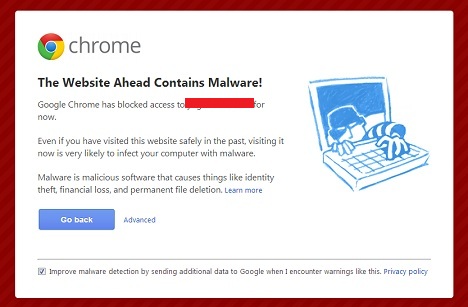Often these days, clients call us after we unhack their Joomla website and tell us that it’s still hacked! So we examine their website and discover that the website is clean. We communicate to them our results, and they get back to us shortly and they say that when they go to their website on Chrome they see something like the following:

So we explain to our clients how Google works with hacked websites:
- When the website is first hacked, Google gives that website the benefit of the doubt – something like a grace period to allow the owner/administrator of the website to take action. During that grace period, Google’s penalty will be restricted to new pages on the website (they will not be indexed), old pages on the website, however, will maintain their rankings.
-
If the website is not fixed within that grace period (most likely because the website admin did not notice, which is usually the case especially when it’s a Googlebot hack), then Google will label the website as malware in its search engine results (which means that the message This website contains malware or This site may be compromised will be next to each listing belonging to this website). The (bad) reputation of the website will be communicated to FireFox and to Google Chrome – both browsers will show warning messages to visitors, telling them not to visit the website (or to visit the website at their own risk). Google usually sends a warning to the site administrator at this point telling him that his website is hacked.
-
If the site administrator ignores the issue for one reason or the other, then Google will penalize the website by shifting listings pertaining to this website to the third or the fifth page of the search results. This is called the +30 or the +50 penalty. This penalty will be in addition to previous penalties.
-
When some time goes by after the +30 or the +50 penalty, then Google will deem this website as unimportant (if it was important then the site administrator would have taken immediate action to address the issue) and will completely delist it from its search results.
In most cases, our clients tell us to fix their websites when their website reaches step 2 in the Google’s website flagging process above – which means that they contact us when their website has already been labeled as hosting malware. Which, in its turn, means that when we fix the website, those flags won’t be removed until Google re-checks the website and verifies that it’s clean – which may happen in a day, a week, or even a month!
Now, the question is, is there a way to expedite the unflagging of your Joomla website?
In fact, there is. All you need to do is to submit what Google calls a reconsideration request which can be done from Google’s Webmaster Tools. Keep in mind that asking Google to reconsider your website will not automatically unflag it, but it will bring the website to the attention of some (human) professionals who may unflag the website before the automated process does.
Is the website redeemable once its past point 2 in Google’s website flagging process?
It is redeemable, but the more you wait, the harder and longer it’ll be to restore your website’s reputation with Google. It may take several months (even a year), along with several petitions and reconsideration requests for some websites to be re-indexed with Google.
If your hacked Joomla website was fixed but you still see that Google and some browsers are warning against using it, then we suggest you give it some time until Google lifts the warning. If your website, after a week or so of fixing it, is still labeled as containing malware, then most likely it was not cleaned properly the first time or it was re-hacked. We suggest you contact us to address the problem for you. We are security experts on Joomla, we are fast, we are reliable, and our fees are quite affordable!
